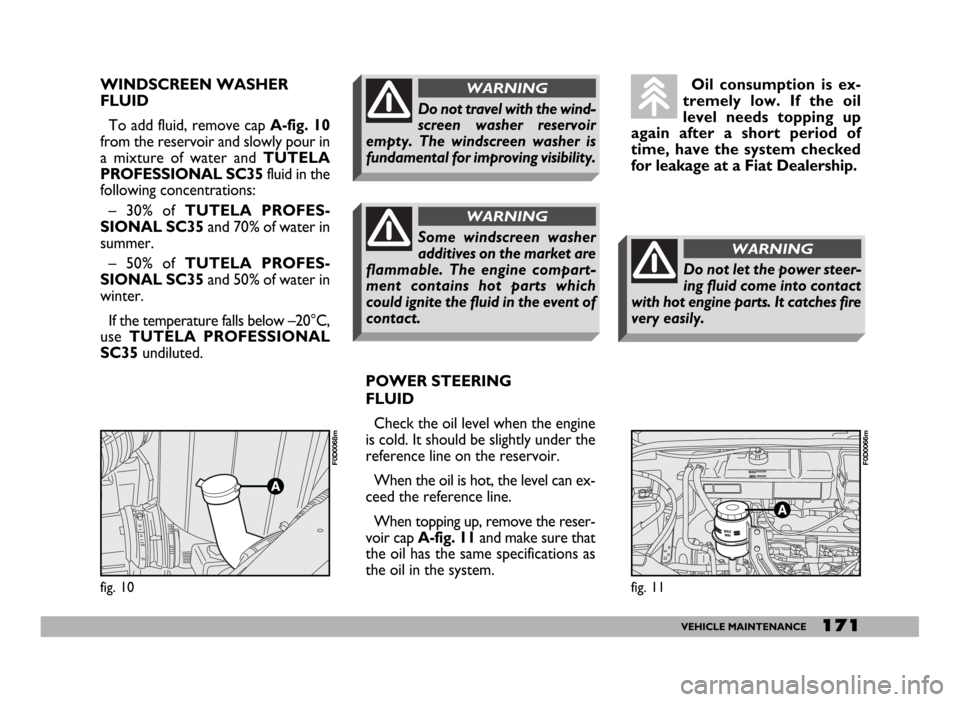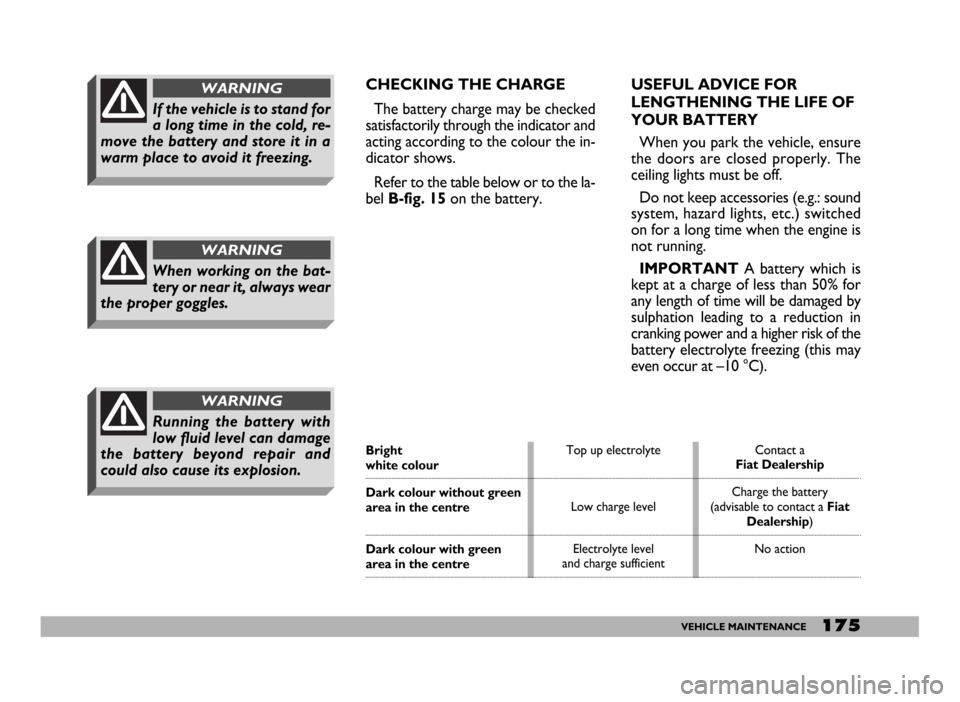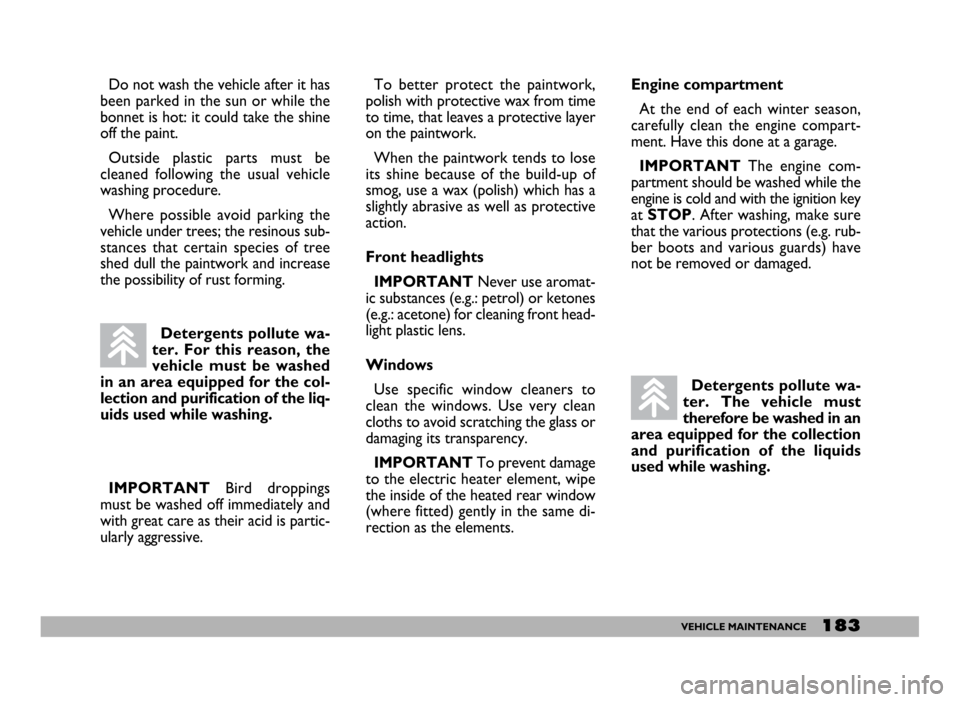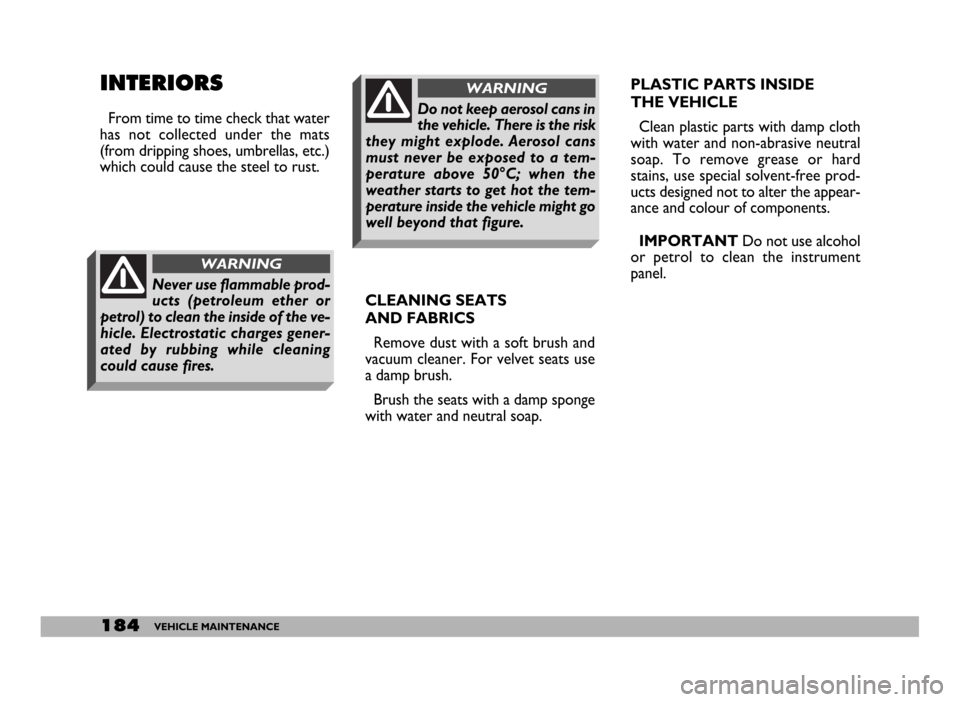Page 146 of 258

145IN AN EMERGENCY
REAR LIGHT CLUSTER
To replace a bulb proceed as follows:
1)loosen the two screws A-fig. 20
with a screwdriver
2)remove the light cluster Band dis-
connect connector C
3)loosen the two screws D-fig. 21
and remove the light cluster:
E- stop light bulb;
F- bulb for reversing light
G - bulb (amber) for direction indi-
cators
H- twin-light bulb for rear fog light
and taillight
fig. 20
F0D0073m
FRONT DIRECTION
INDICATORS
To replace the halogen bulb proceed
as follows:
1) remove the headlight as described
previously;
2)release the retaining clips A-
fig. 15 and remove the cover B;
3)remove the bulb holder D-fig. 16;
4)remove the bulb F-fig. 17push-
ing it slightly and turning it anticlock-
wise at the same time;
5)after replacing the bulb refit the
bulb holder and the cover B-fig. 15.SIDE DIRECTION
INDICATORS
To replace the bulb proceed as fol-
lows:
1)Press the lens in the direction
shown fig. 18
2)remove the bulb holder A-fig. 19
turning it slightly and replace the bulb
B.
FRONT FOG LIGHTS
To replace these bulbs contact a Fi-
at Dealership.
fig. 18
F0D0137m
fig. 19
F0D0138m
Page 154 of 258

153IN AN EMERGENCY
System/Component
CBA (battery fusebox)
Body-builders’ current socket
Alternator
Alternator (2.0 - 2.0 JTD with heating system)
Alternator (2.8 JTD with heating system - 2.0 JTD
with climate control system)
CVM protection
CFO protection
CFO (optional fusebox under the dashboard on passenger’s side
for LH drive versions, on driver’s side for RH drive versions)
Webasto unit
Additional climate control
Chronotachograph
Phone
Alarm
Remote control
ABI for right power window
ABI for door lock
Alarm blinker
Rotating lights (Ambulance versions)
Webasto timer
ABI for left power window
Food box power
Additional heater fan
Left heated rear window
Door mirror defrosting device
Right heated rear window
Driver’s seat warmerFuse no.
F 73
F 72
F 72
F 72
F 70
F 71
F 61
F 56
F 34
F 34
F 34
F 34
F 48
F 38
F 60
F 63
F 58
F 47
F 59
F 57
F 54
F 41
F 40
F 45Ampere
70
125
70
100
150
80
20
30
10
10
10
10
20
20
10
30
5
20
15
15
15
10
15
15Location
Fig. 34
Fig. 34
Fig. 34
Fig. 34
Fig. 34
Fig. 34
Fig. 38
Fig. 38
Fig. 38
Fig. 38
Fig. 38
Fig. 38
Fig. 38
Fig. 38
Fig. 38
Fig. 38
Fig. 38
Fig. 38
Fig. 38
Fig. 38
Fig. 38
Fig. 38
Fig. 38
Fig. 38
Page 163 of 258

162VEHICLE MAINTENANCE
V V
E E
H H
I I
C C
L L
E E
M M
A A
I I
N N
T T
E E
N N
A A
N N
C C
E E
SCHEDULED
SERVICING
Correct maintenance of the vehicle
is essential for ensuring it stays in tip-
top condition for a long time to come.
This is why Fiat has programmed a
number of service checks and opera-
tions carried out every 30,000 kilo-
metres.
It is however important to remem-
ber that "Scheduled Servicing" is not
all your vehicle requires. Regular
checks - also in the initial period be-
fore the 30,000 kilometre coupon and
later between coupons - ordinary care
is required, such as checking fluid lev-
els and topping up, checking tyre in-
flation pressure, checking cleanness of
bonnet and boot locks, cleaning and
lubricating levers, etc...If it is seen that further replacements
or repairs are necessary in addition to
the work being carried out, these will
only be done after the customer has
given his/her consent.
IMPORTANTYou are recom-
mended to get in touch with a Fiat
Dealershipimmediately if any small
running problems crop up without
waiting for the next coupon.
If the vehicle is fre-
quently used to tow trail-
ers, carry out the sched-
uled service operations more fre-
quently than shown.
IMPORTANTThe Manufacturer
requires the Service Schedule coupon
related checks to be carried out. Fail-
ure to do so could result in the war-
ranty being cancelled for those defects
that can be attributed to such failure.
Scheduled Servicing is performed at
all Fiat Dealershipsand there is a set
time scale for such operations.
Page 172 of 258

171VEHICLE MAINTENANCE
WINDSCREEN WASHER
FLUID
To add fluid, remove cap A-fig. 10
from the reservoir and slowly pour in
a mixture of water and TUTELA
PROFESSIONAL SC35fluid in the
following concentrations:
– 30% ofTUTELA PROFES-
SIONAL SC35and 70% of water in
summer.
– 50% ofTUTELA PROFES-
SIONAL SC35and 50% of water in
winter.
If the temperature falls below –20°C,
useTUTELA PROFESSIONAL
SC35undiluted.
POWER STEERING
FLUID
Check the oil level when the engine
is cold. It should be slightly under the
reference line on the reservoir.
When the oil is hot, the level can ex-
ceed the reference line.
When topping up, remove the reser-
voir cap A-fig. 11 and make sure that
the oil has the same specifications as
the oil in the system.Oil consumption is ex-
tremely low. If the oil
level needs topping up
again after a short period of
time, have the system checked
for leakage at a Fiat Dealership.
fig. 10
F0D0068m
fig. 11
F0D0066m
Do not let the power steer-
ing fluid come into contact
with hot engine parts. It catches fire
very easily.
WARNINGSome windscreen washer
additives on the market are
flammable. The engine compart-
ment contains hot parts which
could ignite the fluid in the event of
contact.
WARNING
Do not travel with the wind-
screen washer reservoir
empty. The windscreen washer is
fundamental for improving visibility.
WARNING
Page 176 of 258

175VEHICLE MAINTENANCE
When working on the bat-
tery or near it, always wear
the proper goggles.
WARNING
Running the battery with
low fluid level can damage
the battery beyond repair and
could also cause its explosion.
WARNING
If the vehicle is to stand for
a long time in the cold, re-
move the battery and store it in a
warm place to avoid it freezing.
WARNINGCHECKING THE CHARGE
The battery charge may be checked
satisfactorily through the indicator and
acting according to the colour the in-
dicator shows.
Refer to the table below or to the la-
belB-fig. 15on the battery.USEFUL ADVICE FOR
LENGTHENING THE LIFE OF
YOUR BATTERY
When you park the vehicle, ensure
the doors are closed properly. The
ceiling lights must be off.
Do not keep accessories (e.g.: sound
system, hazard lights, etc.) switched
on for a long time when the engine is
not running.
IMPORTANTA battery which is
kept at a charge of less than 50% for
any length of time will be damaged by
sulphation leading to a reduction in
cranking power and a higher risk of the
battery electrolyte freezing (this may
even occur at –10 °C).
Bright white colour
Dark colour without green
area in the centre
Dark colour with green
area in the centreTop up electrolyte
Low charge level
Electrolyte level
and charge sufficientContact a
Fiat Dealership
Charge the battery
(advisable to contact a Fiat
Dealership)
No action
Page 177 of 258

176VEHICLE MAINTENANCE
Furthermore, remember that high in-
take electric devices (such as baby bot-
tle warmers, vacuum cleaners, cellular
phones, mini-fridges, etc.) powered
when the engine is offcan deploy
the battery.
IMPORTANTWhen installing ad-
ditional systems on the vehicle, bear
in mind that improper branches on
connections of the vehicle wiring are
dangerous, particularly if safety devices
are involved.
Battery
60 Ah
88 Ah
100 Ah
The total intake of these systems
(factory and after-market) must be
less than 0.6 mA x Ah (of the bat-
tery) as shown in the following table:
Maximum
admitted stand-by
intake
36 mA
52.8 mA
60 mA
If the vehicle is inactive for a long pe-
riod of time, refer to the “Vehicle stor-
age” paragraph in section “Getting the
best out of you vehicle”.
Before performing any operation on
the electrical system, disconnect the
battery negative cable.
Battery terminals shall always be
perfectly separated.
If you want to add accessories after
buying the vehicle (antitheft system,
free-hand phone kit, radio navigator,
etc.) visit a Fiat Dealership. They
can suggest the most suitable acces-
sories to get and check whether the
electric system can support the
required load or whether a higher
capacity battery is required.
These devices will, in fact, run off
the battery even when the key is not
inserted (vehicle parked, engine off).
Page 184 of 258

183VEHICLE MAINTENANCE
Do not wash the vehicle after it has
been parked in the sun or while the
bonnet is hot: it could take the shine
off the paint.
Outside plastic parts must be
cleaned following the usual vehicle
washing procedure.
Where possible avoid parking the
vehicle under trees; the resinous sub-
stances that certain species of tree
shed dull the paintwork and increase
the possibility of rust forming.To better protect the paintwork,
polish with protective wax from time
to time, that leaves a protective layer
on the paintwork.
When the paintwork tends to lose
its shine because of the build-up of
smog, use a wax (polish) which has a
slightly abrasive as well as protective
action.
Front headlights
IMPORTANTNever use aromat-
ic substances (e.g.: petrol) or ketones
(e.g.: acetone) for cleaning front head-
light plastic lens.
Windows
Use specific window cleaners to
clean the windows. Use very clean
cloths to avoid scratching the glass or
damaging its transparency.
IMPORTANTTo prevent damage
to the electric heater element, wipe
the inside of the heated rear window
(where fitted) gently in the same di-
rection as the elements.Engine compartment
At the end of each winter season,
carefully clean the engine compart-
ment. Have this done at a garage.
IMPORTANTThe engine com-
partment should be washed while the
engine is cold and with the ignition key
at STOP. After washing, make sure
that the various protections (e.g. rub-
ber boots and various guards) have
not be removed or damaged.
Detergents pollute wa-
ter. For this reason, the
vehicle must be washed
in an area equipped for the col-
lection and purification of the liq-
uids used while washing.
IMPORTANTBird droppings
must be washed off immediately and
with great care as their acid is partic-
ularly aggressive.
Detergents pollute wa-
ter. The vehicle must
therefore be washed in an
area equipped for the collection
and purification of the liquids
used while washing.
Page 185 of 258

184VEHICLE MAINTENANCE
INTERIORS
From time to time check that water
has not collected under the mats
(from dripping shoes, umbrellas, etc.)
which could cause the steel to rust.
CLEANING SEATS
AND FABRICS
Remove dust with a soft brush and
vacuum cleaner. For velvet seats use
a damp brush.
Brush the seats with a damp sponge
with water and neutral soap.PLASTIC PARTS INSIDE
THE VEHICLE
Clean plastic parts with damp cloth
with water and non-abrasive neutral
soap. To remove grease or hard
stains, use special solvent-free prod-
ucts designed not to alter the appear-
ance and colour of components.
IMPORTANTDo not use alcohol
or petrol to clean the instrument
panel.
Never use flammable prod-
ucts (petroleum ether or
petrol) to clean the inside of the ve-
hicle. Electrostatic charges gener-
ated by rubbing while cleaning
could cause fires.
WARNING
Do not keep aerosol cans in
the vehicle. There is the risk
they might explode. Aerosol cans
must never be exposed to a tem-
perature above 50°C; when the
weather starts to get hot the tem-
perature inside the vehicle might go
well beyond that figure.
WARNING